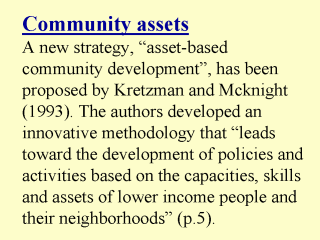 |
The map of
community assets provide a tool for discovering individual and collective capacities and
talents, as opposed to the usual practice: making an inventory of deficiencies of
individuals or communities. It recognizes that each individual has talents, abilities,
interests, and experiences that constitute a valuable arsenal that can be used for
community development. The authors criticize focusing only on the list of problems and
needs of communities for the provision of resources. The “alternative path of
asset-based, internally focused, and relationship-driven” map developed by these authors
is a comprehensive inventory of all possible capabilities of a local community. The
community assets map includes not only individual’s strengths but also citizen
associations like churches, clubs, cultural groups, and local institutions like schools,
libraries, hospitals, universities, parks, etc. Internally focused refers to concentrating
on the problem-solving capacities of the community. Together they provide answers for
building or rebuilding relationships between and among individuals, local
associations/organizations and institutions. |
